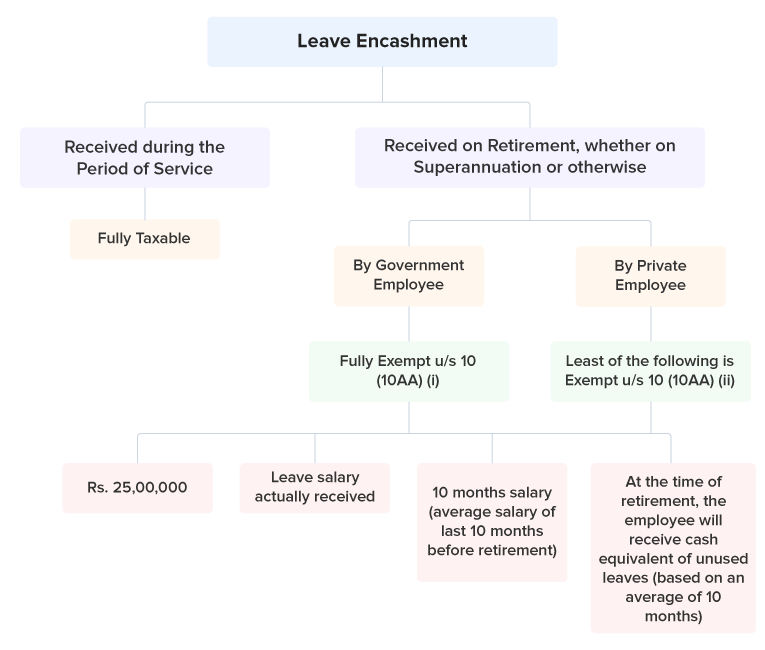Leave Encashment Calculator

Table of Contents
| Particulars | Amount |
|---|---|
| Last Drawn Basic Salary + DA | ₹40,000 |
| Unutilized Leave Days | 5 leaves |
| Leave Encashment Received | ₹6,667 |
What is the Leave Encashment Calculator?
Leave Encashment Calculator is an online tool that helps an individual calculate the amount of money payable for unused leave. This is at the time of resignation or retirement. It helps calculate how much leave encashment an employee is entitled to and also calculates the exempted amount.
How to Use Leave Encashment Calculator (Step-by-Step Example)
- Basic Monthly Salary = ₹35,000
- Dearness Allowance (DA) = ₹5,000
- Total Number of Working Days in a Month = 30 days
- Leaves Allocated by the Company = 3 days
- Number of Unutilized Leave Days = 5 days
Leave Encashment = [(Basic Monthly Salary + DA) / Total Number of Working Days in a Month] * (If Number of Unutilized Leave Days > Leaves Allocated by the Company, use Leaves Allocated by the Company, else use Number of Unutilized Leave Days)
= [(35,000 + 5,000) / 30] * [(5 > 3) ? 3 : 5]
= [(35,000 + 5,000) / 30] * 3
= [40,000 / 30] * 3
= 1333.33 * 3
= ₹4,000
What is Leave Encashment?
Leave encashment meaning includes providing compensation to employees who receive it at the time of resignation or retirement for unused leave. This means that leaves that were not utilized during their employment will be encashed.
These are accrued paid leaves and paid out when employees leave their jobs for various reasons. Employees also receive monetary compensation during their employment in the next financial year, if the company has a leave policy. It helps employees convert their accumulated but unused leave days into cash.
Types of Leaves Eligible for Encashment
There are different types of leave available to employees, like privilege and maternity leave. Some of them can be encashed, and some are not eligible. Here is a table to understand it more clearly.
| Types of Leaves | Description (Varies Across Companies) | Encashment Eligibility |
|---|---|---|
| Privilege Leave / Earned Leave | It is earned over time and used for vacations or personal reasons. | Accumulates and is generally eligible based on the company policy. |
| Casual Leave | It is a short-term leave for unforeseen events and urgent personal work. | It is variable and often not eligible. |
| Sick Leave / Medical Leave | This is regarding an absence due to health-related reasons. | It is eligible sometimes (but mostly not). |
| Sabbatical Leave | Sabbatical leave is an extended leave for upskilling or personal reasons. | It is eligible, depending on the company policy. |
| Holiday Leave | These are paid leaves for designated holidays, festivals, and weekly offs. | It is eligible when applicable. |
| Maternity Leave | Maternity leave is provided to female employees for childbirth and recovery. | It is not eligible. |
| Compensatory Leave / Comp Off | Comp off is provided to employees for working on holidays or overtime. | It is not eligible. |
| Other Special Leaves | Leave is provided for marriage or new fathers as paternity leave. | It is not eligible. |

Leave Encashment Exemption under Section 10 (10AA)

Under Section 10 (10AA) of the Indian Income Tax Act, at the time of retirement or resignation, leave encashment received is eligible for exemption. It has specific rules to be understood with the help of the following image.
Note: Earned/privilege leave encashment cannot exceed 30 days for each year of actual service offered for the employer from whom he retired.
Leave Encashment Calculation with Example
Leave Encashment formula = [(Basic Monthly Salary + DA) / Total Number of Working Days in a Month] * (If Number of Unutilized Leave Days > Leaves Allocated by the Company, use Leaves Allocated by the Company, else use Number of Unutilized Leave Days)
Here is an example for an employee in India:
An employee has completed 15 years of service and is entitled to 30 days of leave per year. The employee has utilized a total of 100 days of leave, and the basic salary structure, along with dearness allowance, is ₹40,000 per month.
Summary in a table format:
| Particulars | Example Values |
|---|---|
| Years of Service | 15 |
| Annual Paid Leave | 30 days |
| Total Leaves Entitled | 450 days |
| Leaves Availed | 100 days |
| Unused Leaves | 350 days |
| Basic + DA (Monthly) | ₹40,000 |
| Per Day Salary | ₹1,333.33 |
| Encashable Amount | ₹4,66,667 |
Sample Calculation for Leave Encashment:
Daily salary: ₹40,000 ÷ 30 = ₹1,333
Leave encashment amount: 350 × ₹1,333 = ₹4,66,667

Taxation on Leave Encashment
Government employees: The entire leave encashment may be exempt from tax.
Private employees: The following shows how to calculate leave encashment for employees working in the private sector and its exemption.
| Particulars | Amount (in ₹) | Amount (in ₹) |
|---|---|---|
| Leave Salary received at the time of retirement | ₹4,66,666 | |
| Less – Exemption u/s 10(10AA)(ii) – least of the following | ||
| Statutory Limit | ₹25,00,000 | |
| Leave salary received | ₹4,66,666 | |
| 10 months’ salary based on the average salary of the last 10 months | ₹4,00,000 | |
| Cash equivalent to unavailed leave based on the last 10 months’ average salary (30,000/30*320) | ₹4,66,666 | |
| ₹4,00,000 | ||
| Taxable Leave Salary | ₹66,666 |
Organizations should note that only basic salary and dearness allowance (unless otherwise specified by company policy) are included in this calculation. It also depends on the company’s policy and does not include other allowances like HRA.
Each employer has specific policies/rules related to the maximum number of encashable leaves and which leave types qualify. Employees need to consult HR professionals for details within their organization.

How to Maximize Leave Encashment Benefits?
Employees should make the most of their leave encashment and maximize the benefits. There are various steps to consider. These are:
- Review the company’s leave policy: Check the company’s leave policy, as every organization has different rules for encashment.
- Plan and manage leaves wisely: The leaves should be planned accordingly. In other words, if an employer provides encashment at the end of service, the leaves should be collected to get the benefit.
- Understand the tax rules: Employees should understand the company’s salary structure tax exemptions, which can result in casual financial benefits.
An individual should understand their company’s leave policy to plan their leave and manage their finances. Every organization has different types of leave, and it is essential to be aware of company-specific rules for maximizing leave benefits.
Whether employees are encashing during employment or at retirement, the leave encashment formula and tax exemptions should be known to avoid confusion in financial decisions. Using an annual leave encashment calculator in India can make the calculation easier for planning benefits.
Final Words
Leave encashment is one way by which an employee receives monetary compensation for the accumulated unused leave. This helps employees benefit from the value of their accrued leave rather than losing it. It is an essential aspect included in an employee’s CTC structure, which ensures that their earned but unused leaves can be encashed.
Organizations are required by law to provide a certain amount of leave to their employees to maintain compliance. Also, providing ample leave can positively impact the company’s work culture and increase employees’ work-life balance. factoHR’s payroll software has built a leave encashment calculator, helping individuals enter relevant details and calculate the amount online.

FAQs for Leave Encashment
What is the Highest Limit for Leave Encashment?
The highest limit for tax exemption on leave encashment is Rs. 25,00,000 as per the latest regulations. The encashment amount exceeding the limit will be taxable under Leave Encashment Exemption Under Section 10(10AA).
What are the Usual Leave Encashment Rules in Companies?
There are multiple rules in companies for calculating leave encashment. Such as:
- Eligible Leave Types
- Encashment Timing
- Limits on Encashment
- Calculation Method
- Taxation
- Application Process
Is Leave Encashment Taxable?
Leave encashment is taxable, and the tax treatment depends mainly on whether it is received during employment or after. It can also be accepted at the time of retirement or resignation, if the employee was in a government/non-government job.
Can all Types of Leave be Encashed?
Not all types of leave can be encashed, as it depends on the company policy. Leaves, for example, earned/privilege and casual leave can be encashed. Leave, like maternity leave and sick/medical leave, cannot be eligible for encashment. Eligibility can vary based on the organization’s rules and whether an employee is in the government or private sector.
Grow your business with factoHR today
Focus on the significant decision-making tasks, transfer all your common repetitive HR tasks to factoHR and see the things falling into their place.

© 2025 Copyright factoHR


